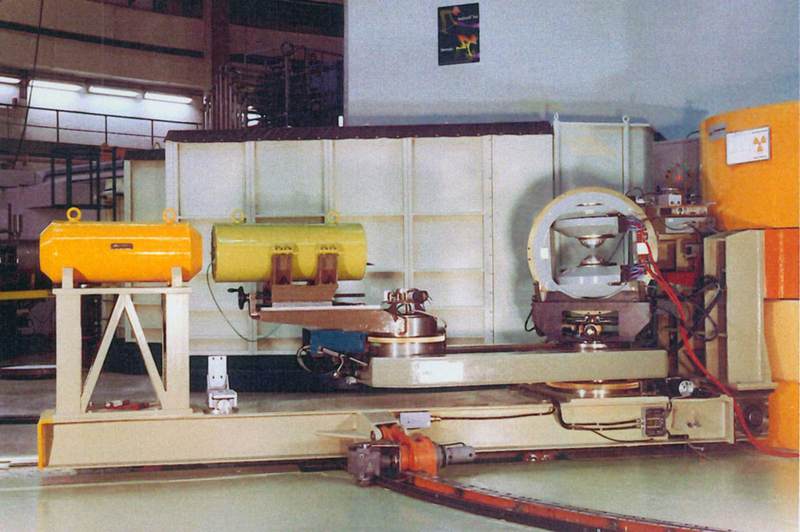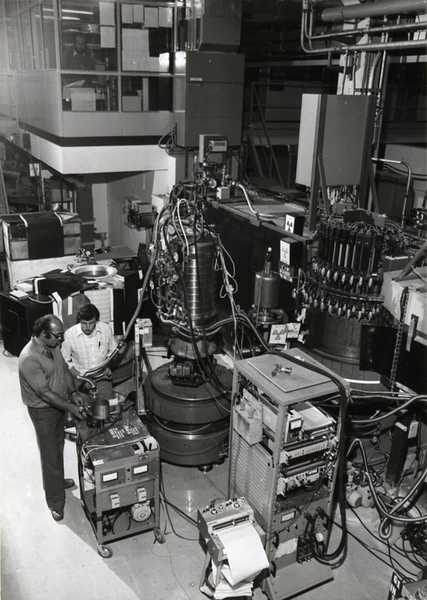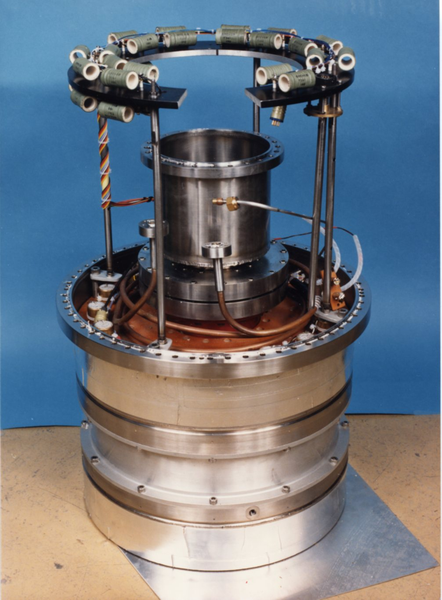High fields
High magnetic fields
with the help of: Peter Suttling (ILL), Roger Pynn (Univ. Santa Barbara/MRL), Jacques Schweitzer (CEA), Jacques Bossy (MCBT/CNRS).
Given their intrinsic magnetic moment, neutrons provide an ideal tool for studying the magnetism of materials at atomic or molecular scales. For that you have to force the orientation of the atomic spins in a particular direction, and that needs intense magnetic fields. The weaker the signal to be observed, the higher the field needs to be.
Enter the cryomagnet!
As early as 1972 a polarised neutron diffractometer like D5 (which has now been replaced by D3) was equipped with a powerful permanent magnet (0.3 Tesla) [1] and an impressive electromagnet of 1.7 Tesla [2,3]; neither of these, however, were powerful enough for some of the experiments required.
What was needed was either a much bigger resistive electromagnet (space-consuming, energy-demanding, water-cooled), or a technological innovation in the form of the cryomagnet. Cryomagnets are made of two superconducting magnetic coils in a bath of liquid helium; they can generate high magnetic fields in volumes compatible with the ILL's instruments and only consume electricity when actually generating the magnetic field.
 (png - 671 Ki)
(png - 671 Ki)The D5 polarised neutron diffractometer, equipped with a 1.7 Tesla electromagnet
©1971 ILL, Jacques Schweizer
The early days
Although there's no trace in the ILL Annual reports it seems that experiments with cryomagnets started very early on, as can be seen from the 1973 photo of D1B sporting a cryomagnet. This magnet doubtless produced a lowly magnetic field, using a traditional magnetic coil.
Peter Suttling thinks it was probably a cryomagnet from Oxford Instruments or the CNRS's SNCI (Service National des Champs Intenses).
The second ILL cryomagnet was probably the one built in 1974/75 by CNRS/SNCI (F. Vallier) for Pierre Thorel's SI16, a small-angle scattering instrument used for studying vortices in type II superconductors. It had a 2-Tesla symmetrical coil. Bill Stirling says that the first coil for a triple-axis spectrometer came from the CEA-CENG and had been built for Mélusine and Siloé.
 (png - 319 Ki)
(png - 319 Ki)The 6-Tesla coil built at the CEA-CENG, nick-named "la poubelle" on IN12 in 1979 (J. Rossat-Mignot, W. Stirling)
©1979 ILL
 (png - 295 Ki)
(png - 295 Ki)Frantz Viallet about 1990
©1990 CNRS/SNCI Grenoble
Specificities at ILL
In the seventies there were three or four companies prominent in the very recent field of superconducting coils; but ILL was looking for something special... a little too special perhaps.
In a classical cryomagnet two identical coil components, flat-cone in shape, are positioned point to point, with a small gap between them. With this mechanically simple symmetrical arrangement
- the magnetic field is at its maximum within the gap; the narrower the gap, the stronger the field. But ILL was looking not only for strong fields but also gaps big enough to lodge good-sized samples.
- At the same time, it needed a non-zero field around the gap to keep the neutron beam polarised as it crosses the cryomagnet; unfortunately, the field around the gap is zero.
The Institute therefore had two unusual requirements which caused many a headache for the manufacturers:
- as high a magnetic field as possible, and a gap between the coils compatible with the size of the neutron beam;
- asymmetric coil blocks to shift the zero field out of the neutron beam.
They had to come up with a specific design - the "asymmetric split-coil magnet" - to allow for the colossal mechanical forces generated by the asymmetric design (nearly 120 tonnes for a 15-Tesla cryomagnet). It was some time before a solution could be found, as the forces involved moved the wires inside the coils when the field was generated and led to a drop in superconductivity ("quenching").
There are still issues today with these "asymmetric split-coil magnets" and the ILL Annual reports show that the road towards high magnetic fields with neutrons has been a long and difficult one.
 (png - 347 Ki)
(png - 347 Ki)Below: superconducting coils. Above: protective electronics
©1987 ILL
Memories
In 1978 Dominique Brochier placed Peter Suttling in charge of the cryomagnets. This is what Peter has to say about ILL's contribution to cryomagnet development:
The manufacturers knew how to make simple coils, but ILL pushed them well beyond the comfort zone. We were asking for bigger gaps and better access, stronger homogeneous flux, coil asymmetry, etc. Firms like Oxford Instruments made a lot of progress thanks to ILL; we were well aware of the difficulties and we never claimed the penalties for late delivery set out in the contracts.
In this battle for high fields with asymmetric coils there were two competing technologies:
- NbTi wires encapsulated in a form of Araldite glue. The problem here was that the slightest air bubble allowed the wires to move within the field, with an immediate loss of superconductivity.
- a stack of NbSn rings. This option was suggested by IGC USA [4] and did work, but the rings moved against each other in the magnetic field. We were never sure of getting the same level of field a second time round. ILL bought a 10-Tesla coil of this type in 1981 for D7.
Peter Suttling also remembers having worked on a dilution insert for a cryomagnet as the high magnetic field created special problems for temperature logging. The first device was installed on an Oxford Instrument Ø50 cryomagnet in 19??.
A high magnetic field story
Roger Pynn remembers what the photo was all about - Instrument IN20, around 1985:
I do recognize it but I don't remember exactly which magnet we were using — probably Jean Paul Boucher's dustbin from the CENG. Someone in the safety bureaucracy told us that we couldn't operate the magnet without having a sign. Probably they asked in a very officious manner because I remember being annoyed and telling them that we would have a sign in every language so that no one would be confused. Apparently I managed to find people who spoke quite a few languages (although I don't see French there — perhaps I was trying to make yet another point). I guess I was somewhat of a pain in the ass to management in those days :-)
Roger Pynn, 19 April 2015
References
D5 was one of the ILL's earliest instruments. It's not on the web, as it was replaced by D3 before documents went digital. Jacques Schweizer remembers some of the details:
- A permanent Ugine-Allevard magnet (0.3 Tesla and a vertical air gap of 5 cm): it was used to align the monochromator's magnetization. Two monochromator crystals (Co-Fe and Heussler) were installed side by side in the air gap.
- (1971-1972) 1st electromagnet (1.7 Tesla): it was mounted on a circular chassis so that it could be installed in either a vertical or horizontal field. In either case a narrow tail cryostat could be used, as there were holes in the poles pieces. The set-up could also be used as an eulerian cradle to orient the crystal, as this version of D5 had no lifting counter.
- (1975) D5's 2nd electromagnet had a horizontal field. A pair of Helmholtz coils could be added to generate a vertical field sufficient to guide the neutron polarisation, provided that the horizontal field was shut down. The count in the horizontal field (spin flip) were compared with that in the vertical field (non spin flip); the difference thus leading to the magnetic diffusion sinceall other contributions were eliminated in the subtraction.
- IGC Polycold Systems Inc. of Petaluma, Calif. Bought up in 2005 by Helix Technology Corp. of Mansfield, Mass. which has now closed down.




